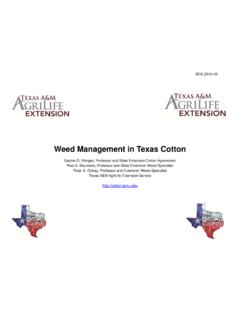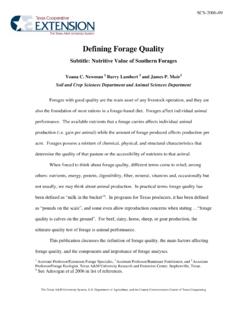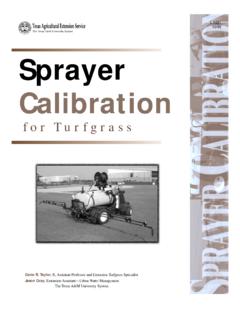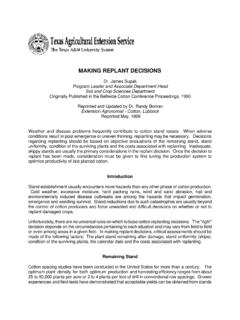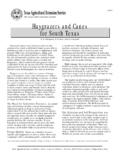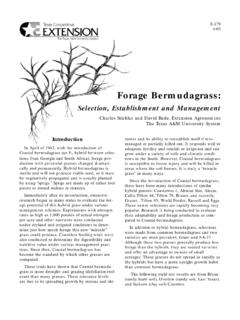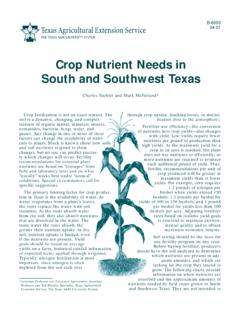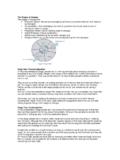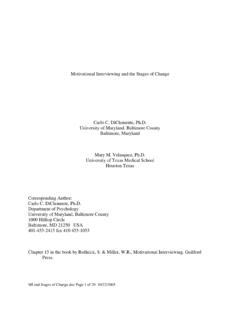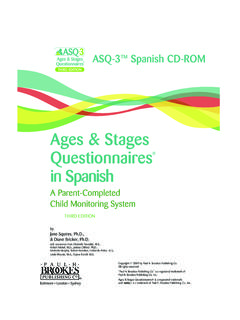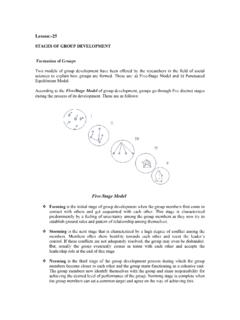Transcription of CORN DEVELOPMENT AND KEY GROWTH STAGES
1 corn DEVELOPMENT AND KEY GROWTH STAGESB rent Bean and Carl Patrick, Extension Agronomist and EntomologistVegetative StageEmergence!Coleoptile leaf (1st leaf) visible. This leaf will be shorter than lateremerging leaves and has a rounded tip.!Growing point of the plant should be 1 to 1 inches below the soilsurface. Permanent (nodal) root system will begin developing at thispoint. If seed is planted too shallow the root system will have a difficulttime becoming !Collar of the 1st true leaf (not the coleoptile leaf) is visible. Plant is stillrelying primarily on seed reserves for !Collar of third leaf visible. Occurs approximately 10 to 14 days afteremergence.!Photosynthesis now very active and supporting the plant.
2 !May apply 2,4-D or Banvel from emergence through the 5th leaf stagewithout drop nozzles.!Begin checking roots for Western corn rootworm larvae (white). Watchcorn that is next to wheat or grass for Banks grass mites infesting lowersurface of !Collar of 4th leaf !Collar of 5th leaf visible. May have lost the coleoptile leaf by this time.!Plant is approximately 8 inches tall. Growing point is just below theground surface. A hail or light freeze will cause little long term damageto the plant. However, flooding while the growing point is below groundcan kill the plant, especially if temperatures are high. !The first internode to elongate is about inch long and is located justbelow the node to which leaf 5 is connected.
3 This is an importantreference for crop GROWTH staging.!Tassel formation has been !Collar of 6th leaf visible. Occurs approximately 3 weeks after emergence.!Growing point and tassel above soil surface making the plant morevulnerable to a hail or freeze.!Permanent root system rather than the seminal roots is now the primaryroot system supporting the plant.!Tillers may begin developing at this stage .!Continue to check roots for Western corn rootworm larvae. Continue tocheck for small colonies of Banks grass !Collar of 7th leaf visible. Plant beginning to grow !Collar of 8th leaf visible. Occurs approximately 4 weeks after emergenceMay have lost lower two leaves.!Don't sidedress after this point or root damage may occur.
4 !Check upper and lower surfaces of leaves for Southwestern andEuropean corn borer eggs or small larvae.!No longer advisable to apply insecticide for Western corn !Collar of 9th leaf visible. Ear shoots are visible in the leaf collar have up to 8 ear shoots.!Tassel is rapidly developing.! corn borer feeding damage should be evident on leaves and in whorl ofinfested !Collar of 10th leaf visible. New leaf stage occurring every 2 to 3 days.!Continue to check for Banks grass mite infestations on lower !Collar of 11th leaf visible. May have lost lower three leaves.!A few corn borers will have entered stalk by this time. No longer feasibleto apply insecticides for corn borer !Collar of 12th leaf visible. Potential number of kernels on each ear andsize of ear being determined, this continues until about 1 week prior tosilking.
5 !Number of kernel rows already determined. Top ear is still smaller thanlower ear shoots.!Brace roots just beginning to develop.!Adequate moisture and nutrients are critical during this Leaves!Leaf STAGES 13 to 17 will develop very rapidly. At some point the tip ofthe tassel will be visible. At which leaf stage this occurs will varybetween hybrids. Silks will begin to grow as tassel is emerging. Braceroots are now growing.!Early maturing hybrids progress from the 13-leaf stage through the 17-leaf stage faster than later maturing hybrids and have smaller ears. Thiscan be compensated by higher seeding rate. !Attempts should be made to have the soil profile full of water prior totassel !Tassel fully emerged. Beginning of a 4 week period that is very is almost at full height.
6 corn is very vulnerable to hail since tasselis fully exposed. Silking will generally begin in 2 to 3 days. Stressoccurring a few days prior to tasseling can cause ear DEVELOPMENT toslow resulting in a lag between pollen shed and silking. This can lead tobarren ears.!Begin to check for 2nd generation corn borer egg lay on StageSilking!Silks visible outside the husks. Most critical stage in the DEVELOPMENT ofthe corn plant.!Takes 24 hours for pollen grain to grow down the silk and fertilize theegg. Generally 2 to 3 days required for all silks to be fertilized on asingle ear.!Number of eggs that are successfully fertilized will determine the numberof kernels that develop on the ear.! corn earworm moths may be laying eggs on silk.
7 !Banks grass mite population may begin to rapidly !Blister stage occurs 10 to 14 days after silking. Kernels are small andwatery.!Continue to check for Banks grass !Milk stage occurs 18 to 22 days after silking. The kernel is a yellowcolor on the outside with a milky fluid inside. Stress at this stage willgreatly affect yield.! corn borer and mites may reach economic !Dough stage occurs 24 to 28 days after silking. The inside of kernelshave a pasty !All kernels dented. Dent stage generally occurs 35 to 42 days aftersilking.!Cob is a dark red color on the majority of hybrids.!Stress at this time will reduce kernel weight but not number. Early frostwill stop grain fill. Frost damaged corn is slow to dry, thus delayingharvest.
8 Maturity!As the kernels are drying down a hard white layer of starch will begin toform beginning at the top of the kernel and progressing to the this hard layer reaches half way down the kernel it is consideredto be at the maturity stage . If the soil profile is full of water at thispoint no more additional irrigation may be Layer!Black layer stage occurs when the starch line has progressed to the baseof the kernel. This can be identified by slicing the kernel and observingthe black line that occurs at the kernel base. Maximum dry matter hasnow accumulated in the kernel.!Moisture content is approximately 30 to 35 percent at black layerformation.

